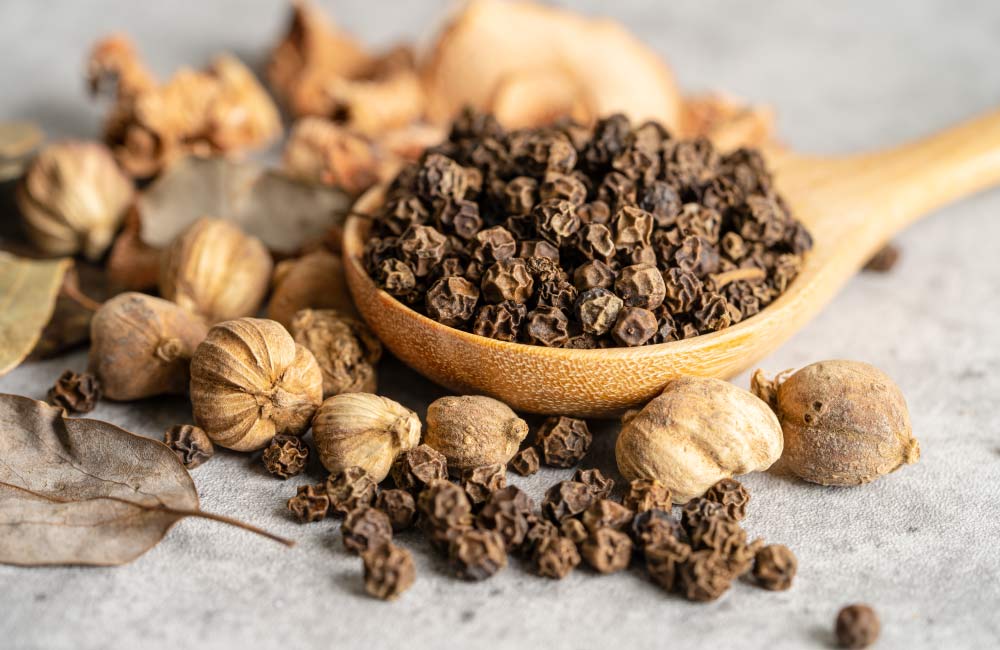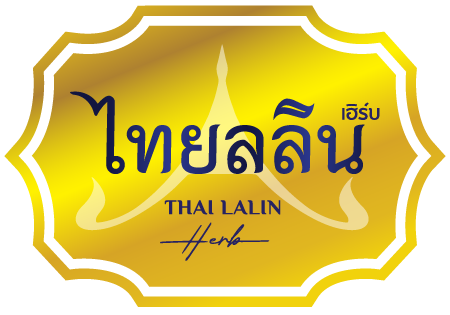
Name of medicine: Thai cardamom
Obtained from: mature fruit that is 4-5 years old, seeds
Name of plant that gives medicine: Thai cardamom
Other names (of medicinal plants): white cardamom (central region, eastern region), galangal, galangal, galangal, mak noeng (northeast), pla kor (Pattani), Mayi (north), black cardamom, red cardamom, cardamom bodhisattva, cardamom moon
Scientific name: Amomum krervanh Pierre ex Gagnep.
Synonyms: Amomum verum
Family name: Zingiberaceae
Appearance of the medicine machine:
The fruit is round, attached in a bunch, about 10-20 fruits, the skin is smooth. Visible lobes, dry and hard, longitudinal streaks on the skin. Arranged from the base to the top, it is a soft white color. The fruit diameter is about 10 millimeters, and the length is about 6-15 millimeters. The head and end of the fruit have a plug, divided into 3 lobes. The old fruit will split. There are many small seeds, divided into 3 groups, about 12 per group. -18 seeds, mature seeds are burnt brown There is a thin membrane between the fruit and the seeds. It has a unique aroma. Smells like camphor, spicy, cool
Good physical and chemical characteristics:
Humidity is not more than 11% w/w. The amount of foreign matter is not more than 1 % w/w. The amount of essential oil is not less than 5 % w/w. The Chinese Pharmacopoeia specifies the amount of cineol not less than 3 % w/w.
properties:
Thai Medicine Textbook: Mature fruit, spicy flavor, fragrant, used to cure flatulence, flatulence, helps expel gas and relieve colic, has the effect of expelling gas and nourishing the elements, correcting irregular elements, nourishing strength, expelling blood, relieving gas in the chest to close the elements. Relieves phlegm to block the elements. Relieves gas in the intestines, improves appetite. Treats melanoma. Cure wind, hiccups, paralysis, anorexia, nausea, vomiting, seeds, treat elemental disabilities. Impairs stool. Nourishes the elements, expels phlegm, relieves stomach pain, expels gas. It is also used mixed with laxatives to relieve stomach symptoms. (nausea and vomiting) such as senna
List of Thai medicines that contain cardamom as an ingredient. namely, the tri-element coordinate consisting of cardamom, anthurium and cinnamon, as a remedy for disability, wind, phlegm, fever;
List of herbal medicines: that have been used according to traditional knowledge according to the announcement of the National Committee on Drugs. Appears to be the use of Thai cardamom fruit. together with other herbs in the recipe In medicines for the treatment of gastrointestinal symptoms, including the drug formula “Yathat Bunp”, used to relieve flatulence. and symptoms of impaired bowel movement non-infectious diarrhea
Form and dosage method: expel wind, relieve flatulence, flatulence, colic and abdominal pain.
Use about 6-10 ripe cardamom fruits (0.6-2 grams), dried and ground into powder. Eat 1-3 teaspoons at a time by bringing to a boil with 1 cup water and simmer until half a cup is left. Eat once Or brew it with warm water to drink.
Chemical Composition:
Contains 5-9% essential oil, which contains camphor, myrcene, limonene, linalool, cineol , bornyl acetate , 1,8-cineol, beta-pinene, alpha-pinene, p-cymene, car-3- ene, terpinen-4-ol, alpha-terpineol, thujone, (E)-nuciferol, alpha-santalol, farnesol isomer, alpha-bisabolol, cinnamaldehyde, (Z)-alpha-trans- bergamotol, safrole, cis-laceol, alpha -curcumene
Pharmacological studies:
antimalarial activity
Antimalarial activity test Of the 7 pure substances isolated from Thai cardamom seeds, 4 are monoterpenes, 1 is a flavonoid, and 2 are thought to be diterpenes (not yet known). The exact structure) found that there were 3 types of monoterpenes: myrtenal, mertenol and tran-pinecarveol. Substance mentioned above (except flavonoids) gave an EC50 value (concentration of drug that can kill 50% of bacteria) in the range of 10 -5- 10 –8 grams per milliliter (Jongdee, 1993).
immune suppressive effect
Test of cardamom fruit aqueous extract in inhibiting the complement (Complement work, in addition to benefiting the body. It can also cause harm to the body, such as causing pathological conditions in patients with autoimmune disease. This experiment is therefore interested in studying herbs that can inhibit complement activity in sheep hemolysis) by taking 53 herbal extracts with water, including cardamom. The plants were dried and finely ground, weighing 1 g., mixed with 20 ml. Then test by mixing the herbal extract with the serum. (complement) and then antibody-reacted sheep red blood cells were added. Look at the hemolysis of sheep red blood cells. It was found that cardamom can inhibit complement function by 95% (Kan Thira, 1998).
Toxicological studies:
toxicity test It was found that when the alcohol-water extract (1:1) was injected subcutaneously or fed to mice at a dose of 10 g/kg (the experimental size was 16,667 times that used in the drug), no toxicity was found (Department of Medical Sciences, 2003)
Study of the toxicity of cardamom seeds It was found that when Thai cardamom seed extract extracted with diluted alcohol:glycerol (95:5) at the concentration of 0.5 g/ml was fed to rats and mice of both sexes at a dose of up to 10 m. g/kg Single dose No test animals died. Rats fed extract at the dose of 2 mg/kg/day for 30 days did not have any abnormalities. compared to the control group The acute toxicity of essential oil obtained from cardamom seeds when fed to rats was found to have a lethal concentration (LD50) of 2.14 ml/kg or comparable to cardamom seeds 43 g. ./kg. The experimental results showed that Thai cardamom seeds were relatively safe (Somjai et al., 1995).
Reference documents:
1. Department of Medical Sciences Ministry of Public Health. 2003. Processing research on toxicology. of the Herbal Research Institute, Volume 1. Religious Printing House: Bangkok.
2. Kantheera Singkam. Study of herbal inhibition of complement function. Bachelor of Science Special Program Faculty of Medical Technology, Chiang Mai University.1998.
3. Chongdee Nilanont. Research on antimalarial compounds from Thai white cardamom seeds. Thesis. Department of Organic Chemistry Mahidol University 1993.
4. Somjai Nakornchai, Yuwadee Wongkrajang, Pranee Jaiart, Pisamai Thipthanasap, Panya Temcharoen. Toxicology of Thai cardamom seeds. Herbal Journal 1995;2(1):7-11.
Convergence medicinal formula information : www.thai-remedy.com


